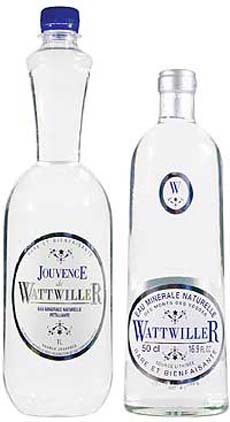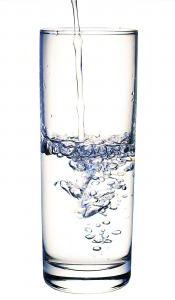
 Discovered in Alsace by Caesar’s legions...and deliverable by the case to you Discovered in Alsace by Caesar’s legions...and deliverable by the case to you!
|
KAREN HOCHMAN is Editorial Director of THE NIBBLE™.
|
|
October 2005
|
 |
Wattwiller Mineral Waters
An Ancient Alsatian With A Soul
Wattwiller has one of the longest pedigrees of any water. Written record was first made by the Romans during their occupation of the area of Gaul now known as Alsace, France. Guarded by hundreds of thousand of hectares of protected forest land, the water is fed by the Muschelkalk aquifer and rises from beneath the earth through a ten-meter screen of clay. As if by special request, two mineral* springs provide two fairly different waters: the Lithinee spring produces only still mineral water, and the Jouvence spring produces a mineral water which has a natural carbonation. Either version is a rare treat; and since the acquisition by the Spadel Group in January 2004, the bottle presentations are stunning. (Spadel is the Belgian water company whose flagship brand is Spa Reine.)
*Mineral water is spring water that has a higher mineral content—a certain threshold of total dissolved substances (salts, sulfur compounds, and trace minerals, e.g.) that alters its taste or gives it therapeutic value.
|
Ancient Gaul
For thousands of years, people have proclaimed that the Water of Wattwiller has a soul.† The Romans discovered and appreciated this source of water: they were great connoisseurs of thermal springs and baths and constructed many structures to enjoy them throughout their empire. At that the time of their occupation, the village of Wattwiller was known as Wasserweiler: the village of water.
†Why “water with a soul?” Perhaps because of people’s affinity for this fine water and its life-enhancing properties. Many waters were believed to be curative. At any rate, it was good P.R., and a reputation that monks of Murbach most certainly spread in the ten centuries that they controlled the water. |
In 735 A.D. the local noble, Count Eberhard, feels that he is close to death. He has no descendants. What should he do with his most precious inheritance, the source of Wattwiller? Heaven inspires him to leave it to the powerful Abbey of Murbach, whose monks jealously controlled it. The influence of its monks extends from Upper Alsace to beyond its borders. For over ten centuries the monks of Murbach will spread the reputation of the waters and baths of Wattwiller.
The first chemical analysis of the water of Wattwiller is carried out by Doctor Morel in 1765. A number of analyses follow, each more precise, but all confirming his studies. Wattwiller water is exceptional, both for its purity and its composition.
In the nineteenth century, the bourgeoisie from Basle and Mulhouse were fervent patrons of the spas of Wattwiller, which had names such as “Villa Bellevue,” “Villa Beauséjour” and “Villa Bonrepos.” In 1850, the National Academy of Medicine issued a Ministerial Decree recognizing the therapeutic values of the water. Alas, between 1914 and 1918, the conflicts of the Great War destroyed these spa establishments.
Resurrection
In 1924 a bottling site was built and the commercialization of this ancient water started anew. For the first time, Wattwiller water was put into bottles and could compete on the world stage, receiving numerous gold prizes and medals. Then, the economic ups and downs of the Second World War and successive changes in ownership lead Wattwiller to simply disappeared for a number of years. From 1954 to 1974, Wattwiller water, slightly carbonated, was commercialized under the name of Lithia. From 1975 until 1992, Wattwiller water was not bottled.
In 1992, the French company, Société Française d’Innovation Industrielle, acquired the park and the spring water sources of Wattwiller. A new bottling unit was constructed, releasing the first bottles of Wattwiller, “Rare Water,” in April 1993. In 1995, in response to a demand by restaurants and hotels, a prestigious 50cl glass bottle was created. Thanks to its innovative design, it soon became a decorative element appreciated by gourmet food-lovers in the best restaurants in France. The year 2002 was marked by the launch of Jouvence, sparkling water with added carbonation (carbon dioxide), in one-liter bottles.
Characteristics
It’s very rare to have both a still and a natural carbonated water from sources in the vicinity. The water has a great presentation in both plastic and glass; absolute pristine source with nitrate levels below detection. There are nice levels of calcium for the bones and bicarbonates which aid in the digestion process. The waters are sodium free (defined as less than 5mg/l per serving per FDA regulation). With a medium mineral content and interesting range of pH factors, these waters works with all foods. They are still very rare in the U.S., making them all the more special.
Today, Wattwiller’s special qualities have earned it fans the world over. Try this wonderful water yourself and see what the ancient Gauls, the conquering Romans, and the modern French, Japanese, and water connoisseurs the world over agree, is a treasure.
| WATER |
Wattwiller Mineral Water |
|
| Origin |
France |
Wattwiller, Alsace
|
| Type |
Still & Sparkling |
|
| WATER ANALYSIS (mg/l) |
Lithinee
(Still) |
Jouvence
(Naturally Carbonated) |
| TDS |
889 |
501 |
| pH Factor |
7.6 |
5.0 |
| Calcium |
222 |
126 |
| Chlorides |
5 |
5.8 |
| Bicarbonate |
142 |
167 |
| Magnesium |
18 |
15.9 |
| Nitrate |
ND |
ND |
| Potassium |
1.6 |
1.8 |
| Sodium |
3.7 |
3.0 |
| Sulphates |
520 |
223 |
| |
|
|
TDS = Total Dissolved Solids
ND = Non-Detectable
LES GRANDES SOURCES DE WATTWILLER MINERAL WATER
Still & Naturally Carbonated (Sparkling) Waters
- Still Water
Glass Bottle
$36.87
- Still Water
PET (Plastic) Bottle
(not shown)
$30.30
- Naturally Carbonated
(Sparkling) Plastic Bottle
(not shown)
$31.49
|

|
 |
To purchase online, visit AquaMaestro.com
Shipping additional. Prices and item availability are verified at publication but are subject to change.

|






